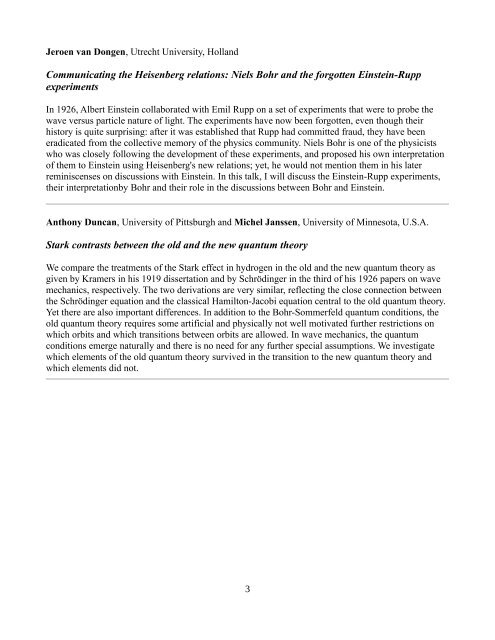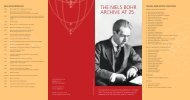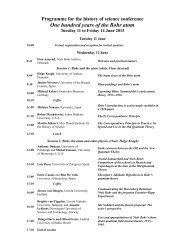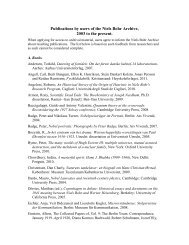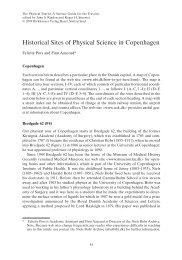Love and physics: Margrethe Nørlund and Niels Bohr's creativity ...
Love and physics: Margrethe Nørlund and Niels Bohr's creativity ...
Love and physics: Margrethe Nørlund and Niels Bohr's creativity ...
Create successful ePaper yourself
Turn your PDF publications into a flip-book with our unique Google optimized e-Paper software.
Jeroen van Dongen, Utrecht University, Holl<strong>and</strong><br />
Communicating the Heisenberg relations: <strong>Niels</strong> Bohr <strong>and</strong> the forgotten Einstein-Rupp<br />
experiments<br />
In 1926, Albert Einstein collaborated with Emil Rupp on a set of experiments that were to probe the<br />
wave versus particle nature of light. The experiments have now been forgotten, even though their<br />
history is quite surprising: after it was established that Rupp had committed fraud, they have been<br />
eradicated from the collective memory of the <strong>physics</strong> community. <strong>Niels</strong> Bohr is one of the physicists<br />
who was closely following the development of these experiments, <strong>and</strong> proposed his own interpretation<br />
of them to Einstein using Heisenberg's new relations; yet, he would not mention them in his later<br />
reminiscenses on discussions with Einstein. In this talk, I will discuss the Einstein-Rupp experiments,<br />
their interpretationby Bohr <strong>and</strong> their role in the discussions between Bohr <strong>and</strong> Einstein.<br />
Anthony Duncan, University of Pittsburgh <strong>and</strong> Michel Janssen, University of Minnesota, U.S.A.<br />
Stark contrasts between the old <strong>and</strong> the new quantum theory<br />
We compare the treatments of the Stark effect in hydrogen in the old <strong>and</strong> the new quantum theory as<br />
given by Kramers in his 1919 dissertation <strong>and</strong> by Schrödinger in the third of his 1926 papers on wave<br />
mechanics, respectively. The two derivations are very similar, reflecting the close connection between<br />
the Schrödinger equation <strong>and</strong> the classical Hamilton-Jacobi equation central to the old quantum theory.<br />
Yet there are also important differences. In addition to the Bohr-Sommerfeld quantum conditions, the<br />
old quantum theory requires some artificial <strong>and</strong> physically not well motivated further restrictions on<br />
which orbits <strong>and</strong> which transitions between orbits are allowed. In wave mechanics, the quantum<br />
conditions emerge naturally <strong>and</strong> there is no need for any further special assumptions. We investigate<br />
which elements of the old quantum theory survived in the transition to the new quantum theory <strong>and</strong><br />
which elements did not.<br />
3


